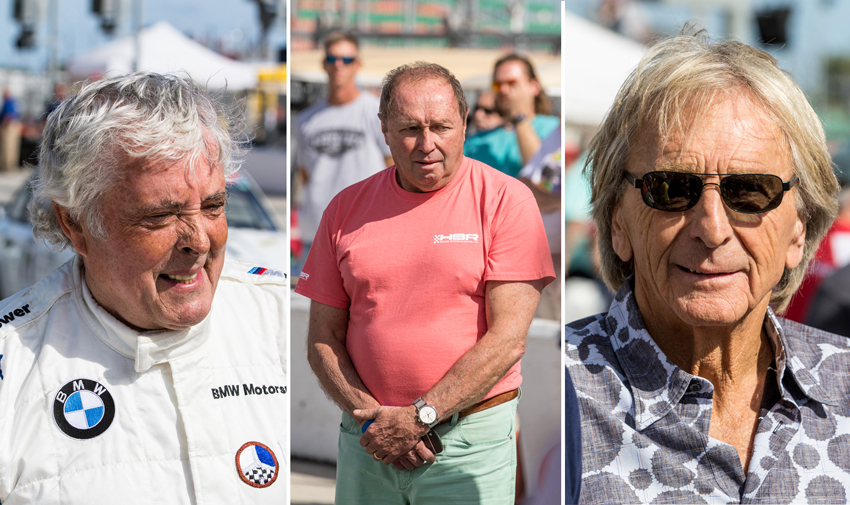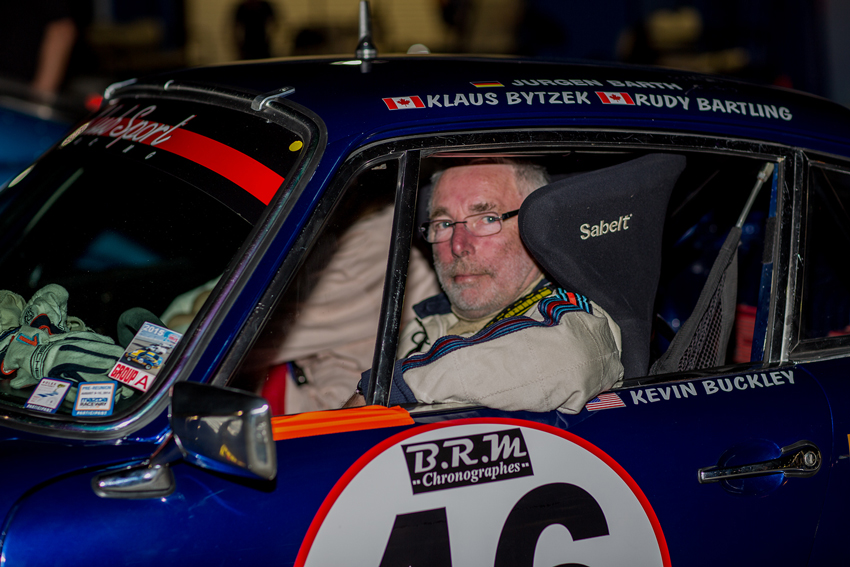It’s tough to say which comes first…the vibration rising through the ground, up your legs, into your torso, rattling your brain…or is it the sound, simultaneously grinding, attacking, and seducing your eardrums with a cacophony of throaty, raspy whines, roars, and rumbles echoing through the Daytona International Speedway. You feel and hear it even before you see that primordial Coliseum-like structure rising in the distance through the early morning mist, as if it were a mirage.


Now in its second year, the Historic Sportscar Racing (HSR) Classic 24 of Daytona, presented by IMSA, seems to be gaining hold in the world of classic vintage racing. It’s thought the event will adopt an alternate-year schedule with the Le Mans Classic in July 2016, to encourage more European entrants to participate at Daytona in 2017. Certainly, the show and spectacle were impressive. More than 300 drivers from 15 countries competed in almost 200 automobiles. Compared to the attention lavished on the August Rolex Motorsport Reunion and September Porsche-themed Rennsport Reunion V, the Classic 24 was a bit of a secret.
Starting mid-week with practice sessions both day and night, the event was an around-the-clock affair in which each of the six historic racing classes ran once every six hours for a total of four one-hour stints: two in daylight and two in the black of night. The cars were required to make at least one five-minute pit stop per session. Sometimes that meant a driver switch, sometimes not. It was designed to give teams and spectators the feel of a 24-hour event while not overtaxing drivers, teams, and cars, some of which are financial portfolio center-pieces.


Entering the infield through the Oval Turn One tunnel, you popped up near turn five of the road course where you’d start to smell the campfires and see the many motorhomes, camper-vans, and tents of the Daytona faithful. Soon you caught a glimpse of a handful of Porsche 962s as they flew past on the banking doing battle with a pair of Group 44 Jaguar GTP cars. Then you felt the rush of air as a couple 1100hp Greenwood Corvettes ripped through the wind. Not long after, an ear-splitting Matra MS630 attacked your senses. You might not have believed your eyes as several Lola T70 Mk IIIs came rushing past you, dicing for position. Then it was a couple of Porsche 935s, a Chevron or two, an Alfa GTV, half a dozen BMW CSLs, and more examples of 60s to early 2000s era 911s. Yes, it was a Porsche-rich field, just as it would have been then. Where the stick and ball and boxing pundits speculate over imaginary match-ups and fantasy teams, the vintage racers delivered…in real time.

You might have felt nostalgic, or you might have found yourself drifting through time to when racing technology was done mostly through intuition, contributing to beautifully round shapes. A wondrous sense of awe came from watching the drivers of these light weight, overpowered cars with big tires and little down-force as they struggled to keep them on the road. They twitched, they slid, then twitched again through the infield section from corner to corner before climbing that impossibly steep banking to test their rev-limiters for 10, 20, 30, and 40 seconds before they got hard on the brakes and started the process over again and over and over…

Listening to an engine wind up to top gear and hold…? Yes, that’s what excited us in the beginning, wasn’t it? It’s not just the fans or the pundits; many of the drivers claim that even if they’re slower, the older cars are more fun.

The Group A class for cars from 1960 through 1972 was dominated both competitively and visually by several Lola T70 Mk IIIs powered by five-liter Chevy engines as they were in period. There were a couple of Chevrons that were incredibly quick and beautiful. But the most exotic entry was a 60s-era Matra MS630, powered by a three-liter DFV Cosworth engine. And many, many Porsche 911s including an original 911 TR, which had placed second in class at Daytona in 1968!


Group B was for cars originally raced from 1973 through 1982. It featured several 935 tribute cars and even a real one. That class was dominated by a couple of Greenwood Corvettes that sounded gloriously rich and induced wheel-spin at nearly every corner exit. Most thrilling was the sight of no less than six BMW CSL cars as raced in their day by drivers like Peter Gregg, Brian Redman, Dieter Questor and others. Another standout was a former Dekon Monza as would have been raced by Al Holbert back in the 1970s.



Group C was a favorite for Porsche cars, as it highlighted the decade from 1983 to 1993. That meant watching the great 962 from a golden era of the old IMSA series. But it also brought about one of the great surprises of the event. While Gunnar Jeannette drove the Rothmans 962 to overall victory in this class, it was followed in second place by Jeff Lewis’s 1993 964 three-liter RSR (who drove solo) and then the 1990 Porsche 964 Cup car, co-driven by Alan Benjamin, Barry Waddell, and Robert Ames.

Group D, for cars from 1994 through 2002, featured several Daytona Prototype cars, including at least one powered by a Porsche flat-six. Several 993- and 996-based racers accompanied them. Group E, for cars from 2002 to 2010, featured Audi, Pescarolo, and Oreca LMP1 cars as well as a Porsche RS Spyder and a few later-generation Daytona Prototypes.

Group F was a kind of catch-all for HSR entries. It included Ferrari 360s, Corvettes, and several smaller displacement sports racers. It was also the most Porsche-heavy class and more than half its entries included 914-6s, 911s, 993s, and 944s. There also were a pair of interesting “tribute” cars, rekindling memories of the days when 904s and 906s raced at Daytona.

Though the drivers and team might argue the point, for the fans present results mattered not. The sights, sounds, and feel of the weekend took us back to an era when power and speed were determined by passion rather than software. Drivers, crew, and spectators all won for being in on this beautiful secret: The Classic 24 of Daytona.




